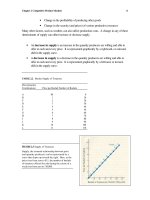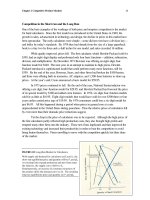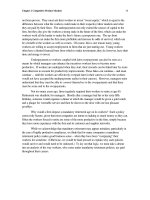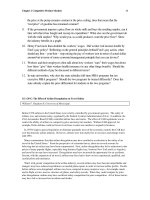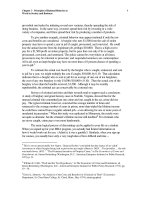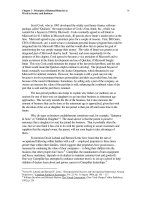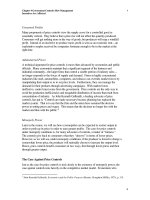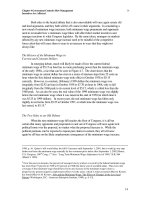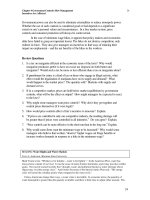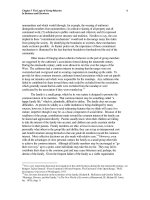Tài liệu Microeconomics for MBAs 41 doc
Bạn đang xem bản rút gọn của tài liệu. Xem và tải ngay bản đầy đủ của tài liệu tại đây (41.19 KB, 10 trang )
Chapter 12 Monopoly Power and
Pricing Decisions
the browser market and a potential competitive threat in the operating system market.
The Justice Department also argued that the market dominance Microsoft now enjoys in
the operating system market could be equated with monopoly power because of the
presumed existence of “high switching costs” and “lock-ins.”
Switching Costs and Lock-Ins
Once people have adopted the operating system, along with the accompanying computer
hardware, and have learned how to use the accompanying applications, there are
presumed costs of switching to other operating systems. To switch, people have to buy a
different operating system, and maybe different computer equipment, as well as learn
new applications that might require different instructions and have a different “look and
feel.” They might also have to retool and retrain their computer service providers, or
switch providers altogether.
Assistant Attorney General Joel Klein introduced “switching costs” into his
argument by first repeating his position that Microsoft was convinced that it could not
win the browser war based on the relative merits of Internet Explorer. He then quoted
Microsoft’s Megan Bliss and Rob Bennett, who wrote in an email that the way to
increase Internet Explorer’s share of the browser market was by “leveraging our strong
share of the desktop”: “[I]f they get our technology by default on every desk, then they’ll
be less inclined to purchase a competitive solution. . . .”
8
The Justice Department’s chief
economist Franklin Fisher gave more details in his testimony for the government, “Where
network effects are present, a firm that gains a large share of the market, whether through
innovation, marketing skill, historical accident, or any other means, may thereby gain
monopoly power. This is because it will prove increasingly difficult for other firms to
persuade customers to buy their products in the presence of a product that is widely used.
The firm with a large market share may then be able to charge high prices or slow down
innovation without having its business bid away” (emphasis added).
9
Fisher added later,
“As a result of scale and network effects, Microsoft’s high market share leads to more
applications being written for its operating system, which reinforces and increases
Microsoft’s market share, which in turn leads to still more applications being written for
Windows than for other operating systems, and so on.”
10
The government’s position on the role of switching costs has been widely adopted
in the media. For example, the editors at The Economist have summed up the network
effects/switching costs/lock-in line of argument very neatly in their retort to Microsoft’s
supporters:
8
Joel I. Klein, et. al., Complaint, United States of America vs. Microsoft Corporation, May 20, 1998 (as
downloaded from www.usdoj.gov/atr/cases3/micros/1763.htm), p. 38.
9
Fisher, Direct Testimony, pp. 15-16.
10
Ibid., p. 27.
Chapter 12 Monopoly Power and
Pricing Decisions
The arguments [that suggest that antitrust laws have no relevance
for today’s information age], plausible as they may seem, are wrong.
‘Network’ effects, in which the value of a product depends on the number
of users, occur in many high-tech markets – just as they did in earlier
industries such as railways and telephones. These effects hugely increase
the risk that that one firm may dominate a particular market, probably not
forever but certainly for a significant amount of time. True, the products
may change, often substantially. But such are the barriers to entry, arising
from large installed bases that are locked into a particular technology and
from control over distribution, that dominant firm can still remain
entrenched.
11
By suggesting that the operating system market is characterized by network
effects that can cause a firm’s market share to build on itself, the Justice Department is
effectively arguing that Microsoft’s current market dominance has been a consequence of
economic forces outside of the company’s influence. If Microsoft’s market position can
be viewed as a product of forces of “nature” – or “technology” – then it might be
rightfully deduced that Microsoft has itself achieved virtually nothing, which can mean
that the Justice Department, by threatening to force Microsoft to put Netscape’s icon on
the desktop, is not violating any property rights Microsoft may have justly earned.
One of the real problems with the Justice Department’s case is that, contrary to
the impression left by all the talk about how network effects build on themselves,
network effects just don’t happen. They are not a part of “nature” or “technology” in the
sense that they exist independent of someone (or some firm) causing them to exist.
Network effects are truly brought into existence, or are created, as someone (or some
firm) works to build the network, and this is necessarily the case. Someone must think of
ways to overcome the initial dilemma: How does a network firm get customers to buy the
product (operating system) when there are no programs, or how does a firm get program
developers to write programs when there are no buyers of the product?
Indeed, the operating system buyers and applications must emerge more or less
together, and the emergence process must be coordinated, encouraged, and directed by
someone (or some firm). And it should be understood that creating the network is likely
to be very expensive, because of buyer and developer resistance, and to require a
substantial up-front investment on the part of someone (or some firm) to overcome the
resistance – Microsoft, for example.
By arguing that networks are characterized by “high switching costs,” the Justice
Department is effectively saying that Microsoft’s market dominance is protected by an
internal barrier to entry, which acts like all barriers and restricts entry. Switching costs
reduce competition, lower consumer choice, and enable the dominant producer to raise its
prices. With high switching costs, the dominant producer doesn’t have to worry about its
customers switching in response to a higher price, or so the Justice Department argues.
Frederick Warren-Bolton, the lead economist for the 19 state attorneys general, reasons
11
“Lessons from Microsoft,” The Economist, March 6, 1999, p. 21.
Chapter 12 Monopoly Power and
Pricing Decisions
that computer “users become ‘locked in’ to a particular operating system [sic],” which
implies a barrier to entry and expansion for existing competitors. He adds, “The software
‘lock-in’ phenomenon creates barriers to entry for new PC operating systems to the
extent that consumers’ estimate of the switching costs are large relative to the perceived
incremental value of the new operating system”
12
The higher the switching costs, the more the dominant producer can raise its price
without fear of the customers switching to existing or new competitors. Indeed, it might
be deduced that if switching costs were the only barrier to entry, then a firm’s monopoly
power – or its ability to raise its price – is limited to the extent of the switching costs. A
firm that tries to charge a higher price than that allowed by the switching costs would find
that it has left its market open to entry by rivals who would find the consumers perfectly
willing to incur the switching costs, because those costs would then be less than the
“staying costs” associated with remaining with the established firm.
By introducing the specter of “lock-ins,” the Justice Department is seeking to
suggest that the switching costs are so high that switching is extremely difficult, if not
impossible, thus presumably fortifying its argument that Microsoft has substantial
monopoly power. Fisher concedes that “market forces and developments can erode
monopoly power based solely on network effects,” but that is precisely why, according to
Fisher, Microsoft felt compelled to engage in “predatory pricing,” to wipe out Netscape
as a potential alternative software platform for running personal computers.
13
Is that the case? Before people accept the Justice Department’s arguments, they
need, at least, to pause and ask whether Microsoft’s pricing strategy is consistent with the
dictates of a market entrenched in network effects. If economics of networks dictate zero
or below-zero prices, then Microsoft’s price for its browser is not necessarily
“predatory,” contrary to what the Justice Department claims.
Lock-Ins and the QWERTY Keyboard
The path dependency/lock-in theory has gained wide support among many academics and
policy makers partially because economic theoreticians and historians have been able to
point to two concrete examples of the supposed wrongs of path dependency and lock-ins.
The classic, widely cited example of path dependency and lock in is the “QWERTY”
keyboard, which takes its name from the way the keys on the far left of the top row of
most keyboards line up.
12
Frederick R. Warren-Bolton, Direct Testimony, State of New York ex rel. Attorney General Dennis C.
Vacco, et. al. vs. Microsoft Corporation, Civil Action No. 98-1233 (TPJ), p. 21 (as downloaded from
Warren-Bolton adds, “Often, switching operating
systems also means replacing or modifying hardware. Businesses can face even greater switching costs, as
they must integrate PCs using the new operating systems and application software within their PC networks
and train their employees to use the new software. Accordingly, both personal and corporate consumers
are extremely reluctant to change PC operating systems” (Ibid., p. 22).
13
Fisher, Direct Testimony, p. 16.
Chapter 12 Monopoly Power and
Pricing Decisions
According to economic historian Paul David, the arrangement for the keys on this
keyboard was first developed in the 1960s for what were then newly invented
typewriters, and this arrangement was developed and adopted only because it minimized
the prospect for the keys jamming as their arms moved toward the paper.
14
The original
keyboard was, supposedly, adopted by one typewriter manufacturer after the other, not
because it was potentially the most productive arrangement of keys, but because it was
established as the “standard.” Manufacturers became further “locked in” to the
QWERTY keyboard when touch-typing was developed in the 1880s and then widely
taught thereafter. David writes, “The occurrence of this ‘lock in’ as early as the mid-
1890s does appear to have owed something also to the high costs of software
‘conversion’ and the resulting quasi-irreversibility of investments in specific touch-typing
skills” (italics in the original).
15
Because of the “lock in” on the key arrangement that was thought to be a
“historical accident,” the QWERTY key arrangement is now widely used on computer
keyboards, but not because QWERTY is better than all potential alternatives. Indeed,
according to this view of keyboard history, “competition in the absence of perfect future
markets drove the industry permanently into standardization on the wrong system – where
decentralized decision making subsequently has sufficed to hold it.”
16
According to what has now become (and proven to be) legend, August Dvorak
and W. L. Dealey developed a keyboard (referred to as the Dvorak or DSK keyboard) in
1932 that has, according to David, “long held most of the world’s records for speed
typing.”
17
Moreover, the Navy supposedly showed in experiments that the greater
productivity from the Dvorak keyboard could more than cover the cost of the required
retraining.
18
However, the Dvorak keyboard has never gotten a toehold in the keyboard
market. Why? The advocates of lock-ins argue there are high switching costs for typists
who are used to the QWERTY keyboard; they would have to learn another key
arrangement. Typewriter manufacturers have never switched to Dvorak because it did
not make good business sense, given they must appeal to the existing typists. Computer
keyboard manufacturers adopted the QWERTY key arrangement because they had no
other choice, given that all (typewriter) typists, who were potential computer customers,
would not buy keyboards with the new key arrangement, in spite of its supposed
superiority. The author of the QWERTY story imagined that “there are many more
QWERTY worlds [in which an inferior standard is adopted by historical accident] lying
14
As reported by Paul A. David. “Clio and the Economics of QWERTY,” American Economic Review,
vol. 75 (1985), pp. 332-337.
15
Ibid., pp. 335-336.
16
Ibid. p. 336.
17
Ibid., p. 332.
18
Ibid., p. 332.
Chapter 12 Monopoly Power and
Pricing Decisions
out there in the past, on the very edges of the modern economic analyst’s tidy universe;
worlds we do not yet fully perceive or understand, but whose influence, like that of dark
stars, extends nonetheless to shape the visible orbits of our contemporary economic
affairs."
19
The implication for the Microsoft case is obvious. If the QWERTY story is true,
then it is plausible that the operating systems market might be one of those “dark stars”
that has become visible, because tens of millions of computer users are similarly locked
in to Windows, even though there might be a superior operating system (such as some
combination of Netscape’s Navigator and Sun’s Java programming language) waiting in
the wings of modern technology to be adopted. However, the superior system doesn’t
have a chance of making it in the market because each Windows user does not, by
himself or herself, have the requisite incentive to make the switch. Unless large numbers
of people make the switch more or less together, then any new user may have a
technically superior system that has few applications written for it.
Fortunately for consumers and unfortunately for the Justice Department’s case,
built partially on the theory of path dependency, the QWERTY story is what we have
called it, a legend – a good story that has taken on a life of its own but is not grounded in
the facts of keyboard history. University of Texas, Dallas Economics Professor Stan
Liebowitz and North Carolina State University Economics Professor Stephen Margolis
did what a lot of QWERTY storytellers should have done long ago: they went back and
researched the history of keyboards and found that much of the evidence on the supposed
superiority of the Dvorak keyboard was from Dvorak’s own studies that were poorly
designed. Even then, Dvorak’s own “evidence was mixed as to whether students, as they
progress, retain an advantage when using the Dvorak keyboard since the differences seem
to diminish as typing speed increases.”
20
The claimed benefits from the Navy study are
similarly disputable, and other studies found substantial retraining costs, leading
Liebowitz and Margolis to conclude that “the claims for the superiority of the Dvorak
keyboard are suspect.”
21
Even if it were proven that the Dvorak keyboard were superior to the QWERTY
keyboard, the future gains from making the switch (in present discounted value terms)
must be greater than the current costs incurred before it can be said that the “wrong”
keyboard continued in use. If the cost of switching were greater than the gains to be
gotten from the switch, switching would constitute a net societal loss (as well as a loss for
employers and/or typists). Liebowitz and Margolis argue that while David made
provocative claims, he never proved his point.
19
Ibid., p. 336.
20
Stan J. Liebowitz and Stephen E. Margolis. 1990. “The Fable of the Keys,” Journal of Law and
Economics, 33 (April), 1-25; as reprinted in Stan J. Liebowitz and Stephen E. Margolis, Winners, Losers,
and Microsoft: How Technology Markets Choose Products (Oakland, Calif.: Independent Institute, 1999),
p. II-30 (galley pages).
21
Ibid., p. II-45.
Chapter 12 Monopoly Power and
Pricing Decisions
The Liebowitz/Margolis finding is altogether understandable. If a keyboard were
substantially more efficient than the established keyboard, it’s hard to see why the new
keyboard wouldn’t be adopted. Granted, some individual typists might be resistant to
making the switch without some outside help. But if the keyboard were substantially
superior, then, as we pointed out earlier in this chapter, it follows that the manufacturer
should have ample incentive to cover some of the typist’s switching costs, through,
perhaps, the provision of retraining courses. Companies that hire large numbers of
typists, or computer users, would also have ample incentives to buy the new keyboard.
They could prorate the retraining costs over a large number of employees from whom
they could garner substantial productivity improvements. Their investment in retraining
could be expected to have an immediate upward impact on their company’s stock price,
given that market watchers would expect the productivity improvement to improve the
company’s long-term profit stream. If the company’s executives were not sufficiently
wise to make the retraining investment, then surely there would be entrepreneurs outside
of the firm who would understand that they could buy control of the company at a low
price, change company policies on things like keyboards, and then sell the company at a
higher price.
Another similar legend has grown up around how the VHS format for
videocassettes tapes and recorders came to dominate the Betamax format, which was
supposedly the markedly superior format of the two. The Betamax format may actually
be technically superior to the VHS format (we are unwilling to judge), but the VHS
format has always had one big advantage over Betamax that counts for more then greater
technical attributes such as a clearer pictures: A whole movie could be recorded on a
VHS tape, which was not possible on the Betamax. VHS became the adopted format
because it met better the needs of the growing home movie rental and sales business.
22
From both fact and conceptual arguments, the presumption that some combination
of path dependency, network effects, switching costs, and lock-ins protect network firms
is wrong, or, at the very least, not proven. If the Justice Department wants to claim that
Microsoft is protected to the same extent (and for the same reasons) as the QWERTY
keyboard and VHS, then we can’t help but concur. However, we would insist that our
agreement means that Microsoft doesn’t have much in the way of long-term market
protection.
Surely, we might imagine that there is an operating system out there that is
marginally superior to Windows and that there might be switching costs that can cause
people to resist switching, but it doesn’t follow that it always makes sense for people to
switch to the superior system (if it is in fact superior and not just claimed to be superior).
The superior system would have to be sufficiently superior to the existing system to more
than cover the switching costs. Any system that has benefits that (in present value terms)
are greater than the switching costs is bound to be adopted, or so it seems to us. Making
the switch then makes too much business sense for too many people to expect otherwise.
Unlike the classic example of “externalities,” in which no one has an incentive to correct
22
Stan J. Liebowitz and Stephen E. Margolis, “Path Dependence, Lock-In and History,” Journal of Law,
Economics, and Organization, (1995) vol. 11, pp. 205-226.
Chapter 12 Monopoly Power and
Pricing Decisions
the problem, there are market solutions to “network externalities.” If Microsoft is acting
like a monopolist, then the switch makes even greater business sense, and should be
viewed as virtually an irresistible temptation for those that have an economic interest in
engineering the switch.
But, then, we have said nothing that is special about the operating system market.
Markets for a variety of goods and services have switching costs, and new entrants have
to find ways of overcoming such costs. New hamburger restaurants have to overcome
customer inertia that might be related to the new restaurant’s lack of reputation for good
food (and clean restrooms). Banks that wish to operate online have the problem of
overcoming people’s resistance to doing their banking on a computer. But businesses
have been creative in finding new ways to cover the switching costs. New restaurants
will often cut their prices below cost, or pass out coupons that have the same effect. A
variety of businesses have offered cash payments or discounts for each online transaction
made. In 1998, Chase Bank advertised that it would pay online customers $25 for each
of the first five online transactions they made. In 1999, after it set up its auction web site,
Amazon.com offered book customers a $10 gift certificate on their first auction purchase.
If there are efficiency improvements to a switch over to another product that mean greater
profits for new firms, “network externalities” (which network effects are sometimes
called) may be “external” to buyers, but those network externalities can be “internalized”
by entrepreneurial firms. Justice Department action is unnecessary to maintain consumer
choice.
MANAGER’S CORNER I: Getting Prices
Right with the Right Incentives
Incentives are necessarily embedded in a firm’s pricing policy. Lowering the price of a
product increases the incentive for consumers to purchase. Conversely, increasing the
price reduces that incentive. Accordingly, people tend to buy more when the price falls
and buy less when the price rises. This inverse relationship between price and quantity is
commonly called the “law of demand.” For a firm to be successful, it has to choose the
“right” price, given the demand (or specifics of the inverse relationship between price and
quantity) for its products. The “right” price achieves maximum profit by striking a
balance between charging more, selling more, and covering the costs of production.
Saying that the firm must choose the “right” price is easier than actually choosing
it. The maxim offers little practical guidance to managers confronting the complex
problem of keeping the firm as profitable as possible. For example, managers can never
be completely sure what the demand for their company’s product is. Moreover, a
company’s demand is not given from on high; it can be influenced by management
decisions. Good managers can increase the demand for their products by improving the
quality of those products, increasing the credibility with which those products are
advertised and their quality is ensured, and establishing a reputation for honesty and fair
dealing. Indeed, much of our previous discussion on different aspects of getting the
incentives right can be thought of as aimed at increasing the demand for the goods and
Chapter 12 Monopoly Power and
Pricing Decisions
services being produced. But demands are also affected by other factors, and many of
them are beyond managers’ ability to control or predict.
So managers, no matter how good they are, will always have to make guesses
about the demands for their products about how much they can sell of their products at
different qualities and prices. There are techniques for estimating product demands (a
discussion of which goes beyond the purpose of this book) and, though these techniques
are never perfect, they can help managers move from making mere guesses to making
educated guesses about their demands.
But even if managers knew all there was to know about the demands for their
products, they would still be faced with tough decisions calling for creative pricing
strategies. In standard discussions of competitive markets, firms have no choice; they
must set the price which competition dictates. Even in the case where the firm has some
choice in setting the price there is no scope for creativity on the part of a firm’s managers.
Given knowledge of the demand and the cost of production, there is only one profit-
maximizing price. Once that price is determined (by the simple rule of charging the price
that motivates consumers to purchase the quantity where marginal revenue equals
marginal cost), the only sensible thing for a manager to do is to charge it. Absolutely no
creativity is involved.
In the real world, there is plenty of scope for creative pricing. And such creativity
can be very profitable. We have discussed throughout this book how firms compete on
many margins. It is common to think of firms competing by producing better products
and charging lower prices. And certainly the long-run consequence of firms struggling
against each other for more consumer dollars is better products at lower prices. But in
this chapter we concentrate on how managers can increase the competitiveness of their
firms by producing more creative pricing strategies. Managers can often do as much or
more for their firms, and their careers, by coming up with better pricing approaches as by
coming up with better products. Of course, as is true of everything else in business,
managers must have the proper incentives to be creative in their pricing strategies.
Fair Prices
Real world managers are not limited to charging only one price for a product (although
fair trade laws and the penalties that go with their violation do restrict the range of pricing
options available to many managers). As those business people who fly frequently know,
there are several different prices being charged for a coach seat (or a first-class seat) on
most flights. For example, passengers who book their flights weeks in advance often pay
less (often several hundred dollars less) than passengers who book their flights days
before their departure. By charging different prices for the same product, firms are able
to earn higher profits than are possible with only one price. Some creativity can be
exercised by carefully announcing prices.
There is a joke based on the pricing creativity of optometrists. When a customer
inquires about the price of a pair of glasses the optometrist answers, “seventy five dollars,”
and then pays close attention to the customer’s expression. If he doesn’t cringe, the
Chapter 12 Monopoly Power and
Pricing Decisions
optometrist quickly adds, “for the lenses.” If the customer still doesn’t cringe, the
optometrist adds, “for each one.”
23
There are, of course, better (perhaps less devious) ways of charging different
prices. Consider the demand you face for a book you have written. Let us suppose that
you can sell 10,000 copies by charging a price of $25 to everyone, thereby realizing total
revenues of $250,000. But you could also sell fewer copies at higher prices. The one
person most anxious to read your book is willing to pay $50 for it; the next most anxious
reader is willing to pay slightly less for it, on down to the 10,000th most anxious reader
who is willing to pay the $25 price at which you could sell all 10,000. You can even sell
more copies, of course, but only by charging less than $25.
How should you price your book? If you could somehow charge each reader the
maximum amount he or she is willing to pay, then you obviously would not sell each
copy for $25. You would charge prices that are higher than $25 on the first 9,999 copies,
which would necessarily yield far more in revenues than you would get by charging $25
for each and every copy.
24
Rarely, if ever, can a seller expect to be able to practice such “perfect” price
discrimination (and sellers need to consult their lawyers to insure that they do not violate
laws that prevent charging different prices to different customers within the same
identified classes of customers that cannot be justified on cost considerations). Even if
the demand is known exactly, so the seller knows the maximum amount that can be
charged for each unit of the product, the seller is unlikely to be able to identify the
consumer who is willing to pay the maximum for each. And if such detailed information
were known, it could still be difficult for the seller to charge each consumer a different
price because of resale possibilities. For example, if resale is easy (meaning cheap),
those who are being charged less than $30 for the book could buy extra copies and sell
them to the most anxious readers (who would otherwise be charged more than $45) for
$35. Such arbitraging reduces the ability of sellers to profit from price discrimination.
But it does not prevent creative managers from finding less than perfect, but still
profitable, ways of charging different prices for a product.
Let’s return to the book example. Book publishers cannot differentiate between
every potential buyer of a book and charge each a different price. But they can separate
the market into two broad categories of buyers, those who are most impatient to read the
latest novel by, say, Tom Clancy, and those who want to read it but do not mind waiting
awhile. If publishers can separate (or segment) these groups, they can charge a different
price to each group. But how can they do that? One method: sell hardback and
paperback editions of the same book. Hardback books are issued first and are sold at a
far higher price than the paperback edition that will not be made available until six
23
As reported by David Friedman, Hidden Order: The Economics of Everyday Life (New York: Harper
Business, 1996), p. 134.
24
By simply assuming that only 10,000 copies of the book are sold, we are ignoring the fact that the number of
copies that maximize profits will generally increase when different prices are being charged for the same
product. Here we are interested only in pointing out that such price discrimination increases the total revenue
received for any given level of sales.
Chapter 12 Monopoly Power and
Pricing Decisions
months or a year later. In this way the seller charges those customers who are less
sensitive to price (or who have an inelastic demand) a higher price than those who are
sensitive to price (or who have an elastic demand). Those customers with inelastic
demands reveal their impatience by their willingness to pay the high hardback price.
There is no problem with arbitrage in this case since those who pay the low price do so
long after the high-price customers have made their purchases.
Of course, sellers don’t always have to package their products differently, as
publishers do, to distinguish between buyers who have inelastic demands and those who
have elastic demands. Just after new, more powerful models of computers are
introduced, their prices can be quite high, only to fall later. Many chalk up the falling
prices on computers to reductions in production costs, which may very well be true.
However, we suggest an additional explanation for why computer prices fall with the age
of the models: the sellers are using time to segment their markets, charging those who are
eager to get the new models a high price and charging those who are less eager and more
willing to wait a lower price.
Department stores almost always have storewide sales after Christmas.
Commonly, the after-Christmas sales are explained by the stores’ wanting to get rid of
excess inventories. There is a measure of truth to that explanation; stores cannot always
judge correctly what will sell in December. However, it is also clear that shoppers have
more inelastic demands before Christmas than they have after Christmas. Hence, the
stores are often doing nothing more than segmenting their markets. They plan to hold
after-Christmas sales and order accordingly. They are not making less money by the
sales; they are, in truth, making more money because they can charge different prices in
the two time periods, attracting customers they otherwise would have lost.
Grocery stores and the suppliers of the products grocery stores sell have also
found a way of getting customers to reveal how sensitive they are to price, which allows
those who are less price sensitive to be charged more than those who are more price
sensitive. In almost every daily newspaper you can find pages of coupons that, if you cut
them out and take them to the designated store, allow you to save 25 cents, 50 cents, and
sometimes a dollar or more, on a host of different products. No coupons, no savings.
Those who go to the trouble of cutting out these coupons and carrying them to the
store are revealing themselves as being relatively price sensitive. So when you fail to
present coupons as you go through the checkout line at your local supermarket, you are
telling the cashier that you are not very sensitive to price, that your demand is relatively
inelastic. The cashier responds by charging you more for the same products than he or
she charged the coupon-laden customer ahead of you. The problem of arbitrage is
handled by limiting the amount a customer can buy of a product. Moreover, not many
people are tempted by the opportunity to buy one bottle of shampoo for 50 cents off and
then trying to sell it for 25 cents off to someone in the parking lot without a shampoo
coupon. The cost of creating the secondary market for something as cheap as shampoo is
surely greater than the price differential, especially when few units can be bought at the
favorable price and sold at a higher price.
